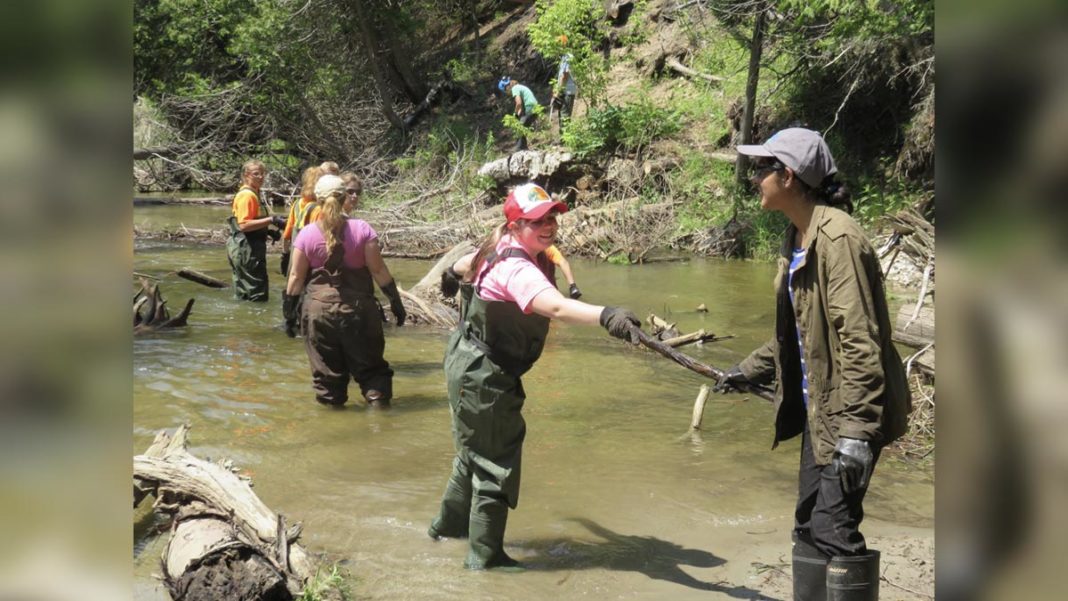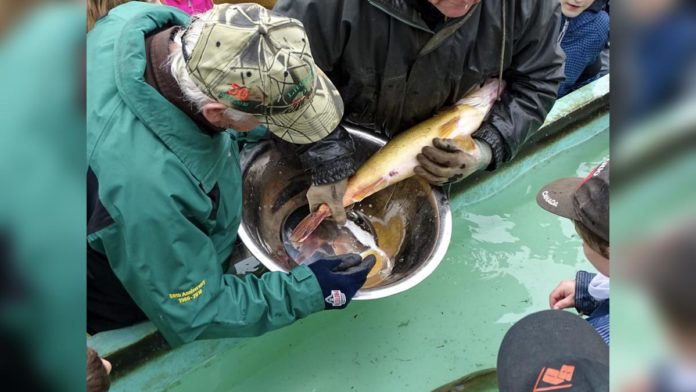KAGAWONG—Climate change is happening on Manitoulin and that impacts riparian zones, those strips of moisture-loving vegetation that grow along the edge of natural water bodies, especially if those areas have already been impacted by agriculture and development. Revegetating riparian zones helps to mitigate those impacts.
Liam Campbell is an environmental technologist with Manitoulin Streams. He began working with the organization in 2018 after earning his BSc. in Environmental Science from Carleton University. He graduated with honours from Algonquin College’s Environmental Management and Assessment post-graduate program in 2020. Manitoulin Streams works in partnership with townships and different communities all over the Island to improve critical habitat and in-stream riparian areas.
Mr. Campbell spoke about riparian zones and climate change at Billings Township’s Earth Day 2022 event on April 23.
Healthy riparian zones are rich in biodiversity. They filter runoff to provide clean water, control erosion and reduce the amount of sediment entering a water body. They also manage storm water and control flooding, provide habitat for wildlife and shade to cool the water.
Agriculture and development have driven habitat loss in riparian zones on Manitoulin for the better part of two centuries, explained Mr. Campbell. Unrestricted livestock access, when livestock can walk to the stream unhindered, leads to vegetation in the riparian habitat being eaten and trampled. If livestock are allowed continued access, that prevents habitat recovery.
“Immediately it results in a lot of habitat loss directly in the riparian zone, and it also increases erosion,” he said. “Not only does it impact the riparian habitat but also the stream itself and any important fish species, like brook trout and rainbow trout, that would live in that stream.”
Livestock access actually changes the structure of the stream, he said. “A natural stream is very meandering, pretty narrow and quite deep. When you have constant movement of livestock in and out of the stream, it makes the stream wider, shallower, and it will straighten it out a little bit. That has implications for water temperature and now, with climate change, can exacerbate it.”
In terms of development Mr. Campbell noted, “When a lot of the communities on Manitoulin were first being developed, we just didn’t know the importance of the streams, so they were essentially channelized and made straight.”
Straightening rivers and streams had the immediate impact of all the vegetation being cut down but also allowed development to occur right up to the edge of the new stream, thus preventing any riparian vegetation from growing again in the future.
It also increased the flow rate within those streams. Without all of those bends and meandering pathways the speed of the water is faster, which increases the rate of erosion. That can and has led to roads and bridge structures washing out. Having a lot of pavement near water bodies also increases run off, which impacts water quality.
Those areas that have already experienced riparian habitat loss are most impacted by current climate change trends on the Island. “The two main things are air temperature and precipitation, specifically the average air temperature and summer extremes,” Mr. Campbell said. “The precipitation pattern that we’re experiencing here is a lot less consistent rainfall throughout the year but very large extreme events.”
Extreme events are leading to increased flooding, and when that happens in an area that has already experienced habitat loss, the rate of erosion is going to increase “pretty significantly,” he said.
Mr. Campbell looked at data collected in Gore Bay from 1935 to 2017, which showed the mean annual air temperature has seen an increase of 0.15°C per decade, “which doesn’t sound like a lot, but over time it starts to add up quite a bit.” The mean maximum annual temperature is increasing at a similar rate (0.16°C per decade).
“The most important thing in terms of air temperature is the summer extremes,” he continued. “With climate change, our summer extreme (maximum) temperatures are actually quite a bit higher than they used to be. That has a big implication for fish like brook trout and rainbow trout that require cold water streams in order to spawn.”
If there is not a lot of riparian vegetation and there has been livestock access, the water body widens substantially and becomes much warmer. “With these extreme temperatures that we’re experiencing from climate change, that’s only going to increase,” said Mr. Campbell.
Repairing riparian vegetation increases bank stabilization, increases biodiversity and mitigates the impacts of climate change on a local level, he said. “By revegetating, you automatically provide more habitat for migratory birds and other wildlife, and prevent more sediment from getting into the stream and impacting spawning fish.”
Mr. Campbell used Manitoulin Stream’s work on Blue Jay Creek as an example of successful revegetation. “The stream itself is quite a bit narrower. It’s very well held together and there are a lot of plants hanging over the edge. All of that creates habitat for juvenile fish. It keeps the temperature of the water lower by providing shade on the edges. All the trees growing in the background also provide shade to the river system.”
It has reduced the average water temperature on the creek by 5°C in the summer and on extremely hot days, keeps the water temperature approximately 10°C lower than it would normally be if it was just exposed to direct sunlight.
The work completed by Manitoulin Streams at the mouth of the Kagawong River provides flood protection as well as runoff mitigation and filtration. Shortly after completion, there was a heavy precipitation and flooding event. The revitalized riparian zone prevented washing out of the bridge, which was one of the main issues at that site to begin with, he said. “The way the water was pushing around was washing out the bridge and the roadway, so now this barrier is basically here to absorb any flood water and it actually acts to absorb any pollutants and agricultural runoff that might be coming from upstream.”
In areas where there has been a lot of agriculture and livestock access, fencing is one of the main preventative actions. Manitoulin Streams also works with farmers because their livestock do need somewhere to get water. At some sites that occur adjacent to livestock areas, they have installed frost-free nose pumps where livestock can get their water year-round. They have also built ramps in certain sections for livestock to get down to the water.
“There’s lots of things that we do,” Mr. Campbell said. “We regrade slopes wherever it’s required, but the main thing that we do that fits all the stream habitats on Manitoulin is the revegetation of the riparian zone. We actually go in there and are planting all of those trees. That’s ensuring the soil is actually going to be held together and that river system is going to be providing all of the ecosystem services it should be in terms of filtering all the water running off, increasing the water quality and it’s also going to sequester carbon into the future. There’s a ton of benefits of having a vegetated riparian zone.”





